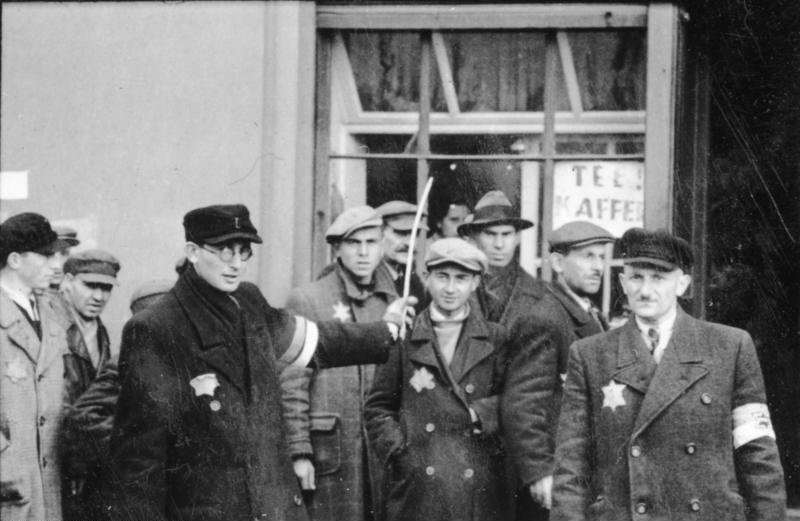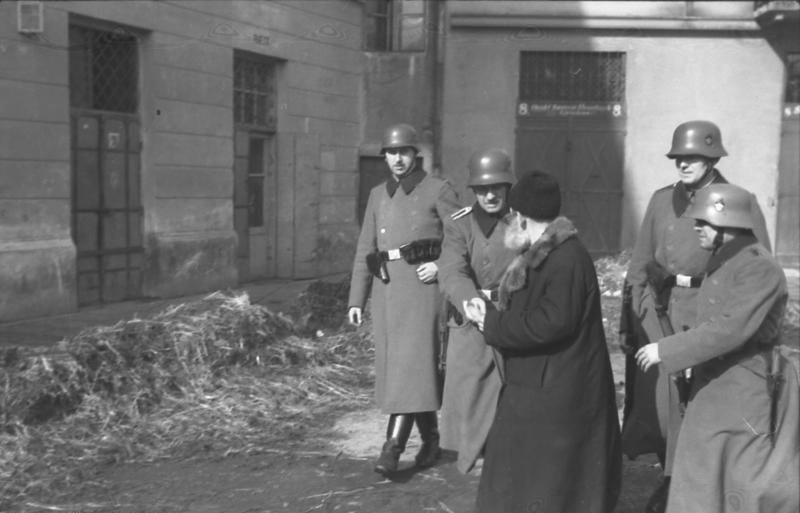|
Będzin Ghetto
The Będzin Ghetto (a.k.a. the Bendzin Ghetto, yi, בענדינער געטאָ, Bendiner geto; german: Ghetto von Bendsburg) was a World War II ghetto set up by Nazi Germany for the Polish Jews in the town of Będzin in occupied south-western Poland. The formation of the 'Jewish Quarter' was pronounced by the German authorities in July 1940. Over 20,000 local Jews from Będzin, along with additional 10,000 Jews expelled from neighbouring communities, were forced to subsist there until the end of the Ghetto history during the Holocaust. Most of the able-bodied poor were forced to work in German military factories before being transported aboard Holocaust trains to the nearby concentration camp at Auschwitz where they were exterminated. The last major deportation of the ghetto inmates by the German SS – men, women and children – between 1 and 3 August 1943 was marked by the ghetto uprising by members of the Jewish Combat Organization. The Będzin Ghetto formed a single ad ... [...More Info...] [...Related Items...] OR: [Wikipedia] [Google] [Baidu] |
The Holocaust
The Holocaust, also known as the Shoah, was the genocide of European Jews during World War II. Between 1941 and 1945, Nazi Germany and its collaborators systematically murdered some six million Jews across German-occupied Europe; around two-thirds of Europe's Jewish population. The murders were carried out in pogroms and mass shootings; by a policy of extermination through labor in concentration camps; and in gas chambers and gas vans in German extermination camps, chiefly Auschwitz-Birkenau, Bełżec, Chełmno, Majdanek, Sobibór, and Treblinka in occupied Poland. Germany implemented the persecution in stages. Following Adolf Hitler's appointment as chancellor on 30 January 1933, the regime built a network of concentration camps in Germany for political opponents and those deemed "undesirable", starting with Dachau on 22 March 1933. After the passing of the Enabling Act on 24 March, which gave Hitler dictatorial plenary powers, the government began isolating Je ... [...More Info...] [...Related Items...] OR: [Wikipedia] [Google] [Baidu] |
Polish Jews
The history of the Jews in Poland dates back at least 1,000 years. For centuries, Poland was home to the largest and most significant Ashkenazi Jewish community in the world. Poland was a principal center of Jewish culture, because of the long period of statutory religious tolerance and social autonomy which ended after the Partitions of Poland in the 18th century. During World War II there was a nearly complete genocidal destruction of the Polish Jewish community by Nazi Germany and its collaborators of various nationalities, during the German occupation of Poland between 1939 and 1945, called the Holocaust. Since the fall of communism in Poland, there has been a renewed interest in Jewish culture, featuring an annual Jewish Culture Festival, new study programs at Polish secondary schools and universities, and the opening of Warsaw's Museum of the History of Polish Jews. From the founding of the Kingdom of Poland in 1025 until the early years of the Polish–Lithuanian Comm ... [...More Info...] [...Related Items...] OR: [Wikipedia] [Google] [Baidu] |
Jewish Ghetto Police
The Jewish Ghetto Police or Jewish Police Service (german: Jüdische Ghetto-Polizei or ''Jüdischer Ordnungsdienst''), also called the Jewish Police by Jews, were auxiliary police units organized within the Nazi ghettos by local ''Judenrat'' (Jewish councils). Overview Members of the Jewish Police did not usually have official uniforms, often wearing just an identifying armband, a hat, and a badge, and were not allowed to carry firearms, although they did carry batons. In ghettos where the Judenrat was resistant to German orders, the Jewish police were often used (as reportedly in Lutsk) to control or replace the council. One of the largest Jewish police units was to be found in the Warsaw Ghetto, where the Jüdischer Ordnungsdienst numbered about 2,500. The Łódź Ghetto had about 1,200, and the Lwów Ghetto 500. Anatol Chari, a policeman in the Łodz Ghetto, in his memoirs describes his work protecting food depots, controlling bakery employees, as well as patrols aimed at ... [...More Info...] [...Related Items...] OR: [Wikipedia] [Google] [Baidu] |
Sosnowiec
Sosnowiec is an industrial city county in the Dąbrowa Basin of southern Poland, in the Silesian Voivodeship, which is also part of the Silesian Metropolis municipal association.—— Located in the eastern part of the Upper Silesian Industrial Region, Sosnowiec is one of the cities of the Katowice urban area, which is a conurbation with the overall population of 2.7 million people; as well as the greater Upper Silesian metropolitan area populated by about 5.3 million people. The population of the city is 194,818 as of December 2021. Geography It is believed that the name Sosnowiec originates from the Polish word ''sosna'', referring to the pine forests growing in the area prior to 1830. The village was originally known as ''Sosnowice''. Other variations of the name include ''Sosnowietz, Sosnowitz, Sosnovitz'' (Yiddish), ''Sosnovyts, Sosnowyts, Sosnovytz, Sosnowytz,'' and ''Sosnovetz''. There are five other smaller settlements in Poland also called Sosnowiec, located in the K ... [...More Info...] [...Related Items...] OR: [Wikipedia] [Google] [Baidu] |
Oświęcim
Oświęcim (; german: Auschwitz ; yi, אָשפּיצין, Oshpitzin) is a city in the Lesser Poland ( pl, Małopolska) province of southern Poland, situated southeast of Katowice, near the confluence of the Vistula (''Wisła'') and Soła rivers. The city is known internationally for being the site of the Auschwitz concentration camp (the camp is also known as KL or KZ Auschwitz Birkenau) during World War II, when Poland was occupied by Nazi Germany. Name The name of the city is of Slavic extraction, possibly derived from the owner of a Slavic gord which existed there in the Middle Ages. It has been spelled many different ways and known by many different languages over time, including Polish, Czech, German, and Latin. The town was an important center of commerce from the late Middle Ages onward. Fourteenth-century German-speaking merchants called it Auswintz; by the 15th century, this name had become Auschwitz. From 1772 to 1918 Oświęcim belonged to the Habsburg the Kingd ... [...More Info...] [...Related Items...] OR: [Wikipedia] [Google] [Baidu] |
Kielce
Kielce (, yi, קעלץ, Keltz) is a city in southern Poland, and the capital of the Świętokrzyskie Voivodeship. In 2021, it had 192,468 inhabitants. The city is in the middle of the Świętokrzyskie Mountains (Holy Cross Mountains), on the banks of the Silnica River, in the northern part of the historical Polish province of Lesser Poland. Kielce has a history back over 900 years, and the exact date that it was founded remains unknown. Kielce was once an important centre of limestone mining and the vicinity is famous for its natural resources like copper, lead and iron, which, over the centuries, were exploited on a large scale. There are several fairs and exhibitions held in Kielce throughout the year. The city and its surroundings are also known for their historic architecture, green spaces and recreational areas like the Świętokrzyski National Park. In sports, the city is known as the home of the top-tier handball club, multiple Polish Champion and one-time EHF Champions Le ... [...More Info...] [...Related Items...] OR: [Wikipedia] [Google] [Baidu] |
Order Police Battalions
The Order Police battalions were militarised formations of the German Order Police (uniformed police) during the Nazi era. During World War II, they were subordinated to the SS and deployed in German-occupied areas, specifically the Army Group Rear Areas and territories under German civilian administration. Alongside detachments from the ''Einsatzgruppen'' and the Waffen-SS, these units perpetrated mass murder of the Jewish population and were responsible for large-scale crimes against humanity targeting civilian populations. Operational history The German Order Police was a key instrument of the security apparatus of Nazi Germany. In the prewar period, Heinrich Himmler, the head of the SS, and Kurt Daluege, chief of the Order Police, cooperated in transforming the police force of the Weimar Republic into militarised formations ready to serve the regime's aims of conquest and racial annihilation. The police units participated in the annexation of Austria and the occupation of ... [...More Info...] [...Related Items...] OR: [Wikipedia] [Google] [Baidu] |
Polish Territories Annexed By Germany
Following the Invasion of Poland at the beginning of World War II, nearly a quarter of the entire territory of the Second Polish Republic was annexed by Nazi Germany and placed directly under the German civil administration. The rest of Nazi-occupied Poland was renamed as the General Government district. The annexation was part of the "fourth partition of Poland" by Nazi Germany and the Soviet Union, outlined months before the invasion, in the Molotov–Ribbentrop Pact.Maly Rocznik Statystyczny (wrzesien 1939 – czerwiec 1941), Ministerstwo Informacji i Documentacji, London 1941, p.5, as cited in Piotr Eberhardt, Political Migrations in Poland, 1939–1948, Warsaw 2006, p.4 Some smaller territories were incorporated directly into the existing Gaue East Prussia and Silesia, while the bulk of the land was used to create new ''Reichsgaue'' Danzig-West Prussia and Wartheland. Of those, Reichsgau Wartheland was the largest and the only one comprising solely the annexed territor ... [...More Info...] [...Related Items...] OR: [Wikipedia] [Google] [Baidu] |
Hitler
Adolf Hitler (; 20 April 188930 April 1945) was an Austrian-born German politician who was dictator of Germany from 1933 until his death in 1945. He rose to power as the leader of the Nazi Party, becoming the chancellor in 1933 and then taking the title of in 1934. During his dictatorship, he initiated World War II in Europe by invading Poland on 1 September 1939. He was closely involved in military operations throughout the war and was central to the perpetration of the Holocaust: the genocide of about six million Jews and millions of other victims. Hitler was born in Braunau am Inn in Austria-Hungary and was raised near Linz. He lived in Vienna later in the first decade of the 1900s and moved to Germany in 1913. He was decorated during his service in the German Army in World War I. In 1919, he joined the German Workers' Party (DAP), the precursor of the Nazi Party, and was appointed leader of the Nazi Party in 1921. In 1923, he attempted to seize governmental ... [...More Info...] [...Related Items...] OR: [Wikipedia] [Google] [Baidu] |
Einsatzgruppen
(, ; also ' task forces') were (SS) paramilitary death squads of Nazi Germany that were responsible for mass murder, primarily by shooting, during World War II (1939–1945) in German-occupied Europe. The had an integral role in the implementation of the so-called "Final Solution to the Jewish question" () in territories conquered by Nazi Germany, and were involved in the murder of much of the intelligentsia and cultural elite of Poland, including members of the Catholic priesthood. Almost all of the people they murdered were civilians, beginning with the intelligentsia and swiftly progressing to Soviet political commissars, Jews, and Romani people, as well as actual or alleged partisans throughout Eastern Europe. Under the direction of Heinrich Himmler and the supervision of SS- Reinhard Heydrich, the operated in territories occupied by the Wehrmacht (German armed forces) following the invasion of Poland in September 1939 and the invasion of the Soviet Union in Ju ... [...More Info...] [...Related Items...] OR: [Wikipedia] [Google] [Baidu] |
Einsatzkommando
During World War II, the Nazi German ' were a sub-group of the ' (mobile killing squads) – up to 3,000 men total – usually composed of 500–1,000 functionaries of the SS and Gestapo, whose mission was to exterminate Jews, Polish intellectuals, Romani, and communists in the captured territories often far behind the advancing German front.Thomas Urban, reporter of the Süddeutsche Zeitung; Polish text in Rzeczpospolita, Sept 1–2, 2001 ''Einsatzkommandos'', along with ''Sonderkommandos'', were responsible for the systematic murder of Jews during the aftermath of Operation Barbarossa, the invasion of the Soviet Union. After the war, several commanders were tried in the Einsatzgruppen trial, convicted, and executed. Organization of the ''Einsatzgruppen'' ''Einsatzgruppen'' (german: special-ops units) were paramilitary groups originally formed in 1938 under the direction of Reinhard Heydrich – Chief of the SD, and '' Sicherheitspolizei'' (Security Police; SiPo). They were ... [...More Info...] [...Related Items...] OR: [Wikipedia] [Google] [Baidu] |








